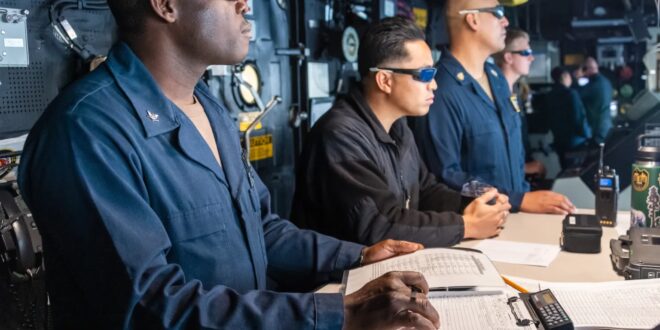A press release from 5th Fleet Public Affairs(NAVCENT) gave a dry report of the USS Portland testing a high-energy laser weapon system while underway in the Gulf of Aden;
“During the demonstration, the Solid State Laser – Technology Maturation Laser Weapons System Demonstrator (LWSD) Mark 2 MOD 0 aboard Portland successfully engaged a static surface training target. Portland previously tested the LWSD in May 2020 when it successfully disabled a small unmanned aerial system while operating in the Pacific Ocean.
The Office of Naval Research selected Portland to host the laser weapon technology in 2018. The LWSD is considered a next-generation follow-on to the Laser Weapon System (LaWS) that afloat forward staging base USS Ponce (AFSB(I)-15) tested for three years while operating in the Middle East.
The region’s geography, climate, and strategic importance offer a unique environment for technology innovation. U.S. 5th Fleet’s area of operations includes the world’s largest standing maritime partnership, Arabian Gulf, Red Sea, Gulf of Aden, Gulf of Oman and parts of the Indian Ocean.”
High Energy Lasers Can Defeat The Speed Advantage of Chinese, Russian and Iranian Hypersonic Missiles
The high-energy laser system(LWSD) has been in development for years and has seen incremental increases in power and range as the system has been tested and refined. The choice of the Gulf of Aden as a testing range was intended to send a message to Iran and China about this emerging weapon system. Both of these potential adversaries have announced that they are fielding hypersonic missiles aimed at destroying US Navy aircraft carriers. These hypersonic missiles rely on speeds as high as Mach 5, wave skimming altitudes, and long-range to reach their target before they can react with anti-missile defenses. At a speed of Mach 5, the target has very little time to detect, target, and get a missile or gun rounds into the air to intercept it.
Solid-state high-energy laser systems hold the promise of being able to engage hypersonic missiles at range because their directed energy beam travels at the speed of light versus the much slower speed of missiles or even 20mm rounds from the Raytheon made Phalanx(CIWS) system aboard ships.
This is not an easy technology to adapt for use at sea. The first system tested on the USS Ponce in 2014 was just 30kw which meant it range was measured in meters since the power of the laser rapidly reduces with the range it projects out to. The system now being test-fired on the USS Portland is 150kw which means it can project its heat energy for miles. As this energy output increases so does the range at which it can do damage. A laser in the megawatt range of output could theoretically cut an enemy ship in half in a few seconds at visual line of sight ranges. Navy ships coming into service recently like the USS Gerald Ford and Zumwalt class frigates can are generating much more electricity than their predecessors. The USS Gerald Ford can produce two and a half times as much electricity as the Nimitz class and the Zumwalt Class produces 75 Mw of power versus the US Navy’s DDG-51 Arleigh Burke Class destroyers which produce about a tenth of that in electrical output. High electrical output will be a very important factor in mounting radars and laser weapons that are entirely powered by electricity.
The lens on these lasers poses some difficulties as well when used at sea. A single drop of water or an oily smudge left by a handprint can damage or destroy the lens when the energy from the laser beam superheats it in an instant. So the lens requires some pretty special handling.
Every Weapon Has A Counter Measure
But the message to China, Iran, Russia, and other countries working on hypersonic missiles will be very clear. Their development of these missiles has compelled the U.S. to develop laser-based defense systems that can not only set hypersonic missiles on fire as they approach but also surface targets and aircraft.
During WWII, as the effectiveness of Japanese planes against American ships kept falling off, they resorted to suicide tactics to improve their ratio of ships lost to ship hit per sortie. What Japan had invented in the Kamikaze was the “smart bomb” we see today in the world’s military. The Japanese figured this would be a game-changer for them in terms of sinking allied ships. The U.S. response was to simply increase the range, speed, shell power and volume of its anti-aircraft fire. As a result, Kamikaze attacks were not any more effective on a number of sorties per hit basis than they were when their best pilots and planes were still alive in 1942, but they lost all the pilots and planes they sent on these missions, while the US Navy’s anti-aircraft guns aboard its ships would still be there to fire again on the next attack.
The point here is that the U.S. is capable of rapidly developing countermeasures to weapons that adversaries spend decades trying to develop at great expense. They may have invested billions in hypersonic missiles only to see the American response be the development of a whole new class of laser weapons that threatens not only their missiles but their ships and planes as well.
 Eurasia Press & News
Eurasia Press & News


